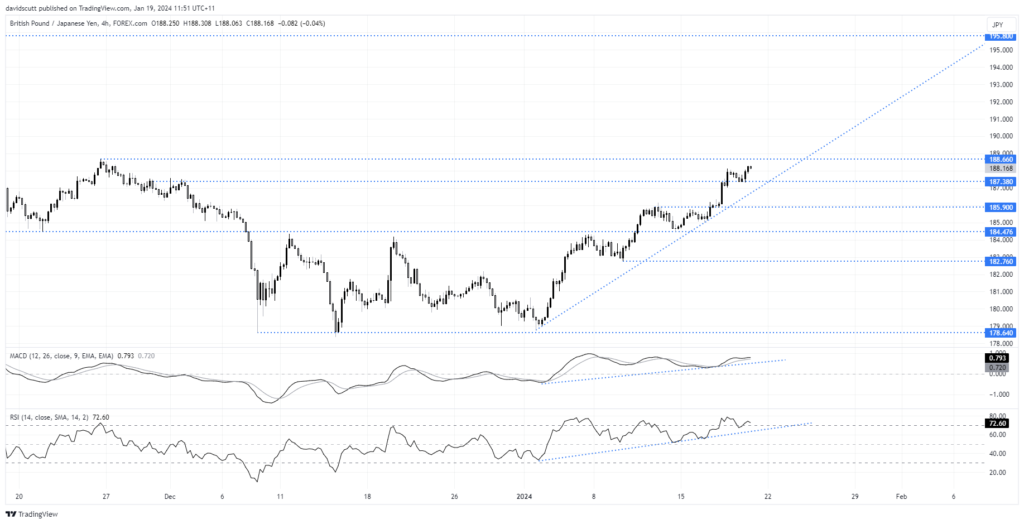Disinflation is taking over Japan, as we have seen in other advanced economies before him, highlighting the difficulties faced by the Bank of Japan (BOJ) to eradicate the deflationary mentality that has haunt the country for decades.
- Japan continues to experience disinflation, like other advanced savings.
- Even if the underlying inflation remains greater than the objective of BOJ, the slowdown in global growth could see disinflation transforming into pure and simple deflation.
- Japanese yen pairs, such as USD/JPY and GBP/JPY, will remain motivated by interest rate expectations outside Japan.
Disinflation is taking over Japan, as we have seen in other advanced economies before him, highlighting the difficulties faced by the Bank of Japan (BOJ) to eradicate the deflationary mentality that has haunt the country for decades. While the short -term prospects for an increase in the rates of the Bank of Japan fade, this means that the prospects for the USD/JPY pair will remain dictated by the fluctuations in American bond yields, which will have an impact on yield differences between the two countries.
According to the Japanese government, inflation dropped by 0.1% in December after a drop of 0.2% in November, seeing the increase compared to the previous year slow down to 2.6% against 2.8% one months earlier. Excluding fresh food products, underlying inflation has further slowed down on an annualized basis, falling to 2.3% against 2.5% in November. The result was in line with market expectations and marked the slowest increase since June 2022.
Inflation remains higher than the objective of the Bank of Japan but slows down
The Bank of Japan aims for an underlying inflation of 2% on the entire economic cycle. Even if the rate remains higher at this level, it has followed a downward trend in the past year, now barely located half the level of 4.2% observed in January of last year.
Excluding food and energy products, underlying inflation-which is more similar to underlying inflationary pressures in other developed economies-increased by 3.7% over one year, still to a Uncomfortable level but slowdown compared to 4.3% recorded in August from last year.
The Bank of Japan faces a delicate path towards possible rate increases
While disinflation persists, the Bank of Japan is faced with a delicate decision as to whether it should start normalizing its monetary policy by abandoning the negative interest rates in force for almost a decade, running the risk of disinflation Until pure and simple deflation by slowing down the economy and strengthening the Japanese yen. . Increasing interest rates while the global economy slows down and other central banks reduce interest rates could easily occur given Japan’s deflationary mentality.
Salaries growth is only one of the factors underlying the expectations of Boj
The decision -makers of the Bank of Japan hope that the salary negotiations which should end at the end of the fiscal year in March will help to promote inflationary forces, thus contributing to stimulating demand and consumer prices. Even if we will not know the result for several months, recent wage data is well below expectations, the markets reducing expectations concerning BOJ rate increases this year.
Regarding Swaps markets, the day -to -day rate is now at only 6 base points, about half of the level observed in October from last year. It was close to 0% last week. Even if this implies that the Bank of Japan will be able to raise the reference rates day to day of -0.1%, the more it will wait to start the process, the greater the risk to do more harm than good .
At this point, the markets bet that the normalization of policies will begin in April, at the very moment when other central banks should start to soften their policies. For the USD/JPY pair, the success of the Bank of Japan is much less important than what happens with American rates since they remain high compared to recent history, which leaves room for bidirectional risks Given the economic uncertainty and the increase in the invoice of the public debt of the United States.
The USD/JPY pair bounces following the expansion of interest rate differentials
With regard to the USD/JPY pair, the expansion of interest rate differences between the United States and Japan in recent weeks has created an environment conducive to lower buyers. For reference state obligations at 10 years, the yield advantage enjoyed by the United States compared to Japan has more than 30 base points since the start of the year, the USD/JPY pair increasing near Eight important figures at more than 148.
Unless global economic activity really begins to be reversed or the markets are added to the already aggressive bets of reducing American rates by almost six reductions of 25 points in 2024, the lower resistance trajectory for the Pair USD/JPY remains higher in the short term, as indicated by the remaining values of the RSI and the MacD in bullish trends.
A break of 148.50 could lead to a thrust around 149.70, bringing the USD/JPY pair closer to the summits of several decades on the Forex reached last year. Lowering, the horizontal support is 147.40 and 146.00, with an upward trend support located between the two. To go even lower, it would probably be necessary to worry more about the prospect of a brutal economic landing worldwide.

GBP/JPY gains thanks to reduced bets on the increase in rates of the Banque d’Engleterre
Like the USD/JPY pair, the GBP/JPY pair has a similar configuration, helped by the outcome of the rate reduction of the Bank of England in response to the inflation figures of services and wax stronger than expected For December. If it manages to clearly cross 188.66-where it stagnated at the end of December, there will not be much visible resistance above 195, which offers potential for extension of the current movement.

David SCUTT is a former trader in cash -speaking securities, in the long term and on the money market with more than 10 years of experience in bank treasury. David also worked as editor -in -chief of the markets and the economy for Business Insider, covering macroeconomic events and the main market events in Asia.
